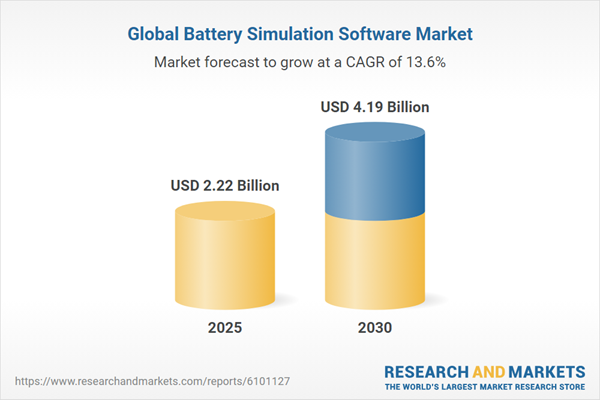Dublin, Sept. 29, 2025 (GLOBE NEWSWIRE) -- The "Battery Simulation Software Market by Simulation Type (Electrochemical, Thermal, Structural & Mechanical, Electrical & Circuit), Battery Type (Li-ion, Lead-acid, Solid-state), End-use Industry (EV Manufacturers, Automotive OEMs) - Global Forecast to 2030" has been added to ResearchAndMarkets.com's offering.
The global battery simulation software market size is projected to grow from USD 2.22 billion in 2025 to USD 4.19 billion by 2030 at a Compound Annual Growth Rate (CAGR) of 13.6% during the forecast period.
Both industrial demand and academic activities are fueling expansion. Companies like UL Solutions and NOVONIX enhance battery life forecasts using AI, while initiatives such as Gamma Technologies' Battery Workforce Challenge give students hands-on simulation experience. This dual momentum ensures that battery simulation tools evolve technologically and integrate seamlessly into future design processes, addressing growing needs in EV, energy storage, and manufacturing sectors.

By battery type, the lithium-ion (Li-Ion) battery segment accounts for the largest market share during the forecast period.
Lithium-ion batteries dominate the market due to their adoption across electric vehicles, consumer electronics, energy storage systems, and industrial applications. Owing to their high energy density and long operational lifespan, advanced simulation tools optimize their efficiency, safety, and durability. EV manufacturers rely on these simulations for thermal management, lifecycle prediction, and performance. In aerospace and heavy industry, precise modeling ensures battery reliability under extreme conditions. As demand for safer and longer-lasting Li-ion systems grows, simulation software is crucial for innovation, reducing prototyping costs, and meeting high safety and performance standards.
By region, North America accounts for the largest market share.
North America leads the battery simulation software market due to strong EV adoption and technological innovation. The growing electric vehicle market in the US and Canada drives demand for advanced battery solutions. Innovations like Honeywell's Battery MXP and AVL's platforms enhance production efficiency and quality. U.S. Department of Energy's QCS program and private-sector funding boost R&D in simulation technologies. Improvements in lithium iron phosphate manufacturing and regional supply chains further optimize simulation tools, enhancing North America's position as a hub for advanced battery technology development.
Competitive Landscape
The key players in the battery simulation software market include Ansys (US), Siemens (Germany), AVL (Austria), MathWorks (US), Dassault Systemes (France), Altair Engineering (US), ESI Group (France), Ricardo (UK), Intertek (UK), Hexagon (Sweden), Synopsys (US), COMSOL (US), dSPACE (Germany), and Gamma Technologies (US). The study encompasses a competitive analysis of these key players, detailing their company profiles, recent developments, and market strategies.
Research Coverage:
The report segments the battery simulation software market by simulation type, battery type, end-use industry, and region, providing detailed forecasts. It includes an in-depth competitive analysis of market players and their company profiles, developments, and strategies.
Key Benefits of the Report:
The report aids market leaders and new entrants by approximating revenue numbers for the battery simulation software market and its subsegments. It helps stakeholders understand the competitive landscape and market dynamics to plan suitable go-to-market strategies. The report also highlights market drivers, restraints, challenges, and opportunities.
The report provides insights on the following:
- Analysis of key drivers, restraints, opportunities, and challenges
- Product Development/Innovation: Insights on technology advancements and product developments
- Market Development: Comprehensive information on lucrative markets
- Market Diversification: Information about new products, untapped geographies, and investments
- Competitive Assessment: Market shares, growth strategies, and service offerings of leading players
Key Attributes:
| Report Attribute | Details |
| No. of Pages | 231 |
| Forecast Period | 2025 - 2030 |
| Estimated Market Value (USD) in 2025 | $2.22 Billion |
| Forecasted Market Value (USD) by 2030 | $4.19 Billion |
| Compound Annual Growth Rate | 13.6% |
| Regions Covered | Global |
Key Topics Covered:
Market Dynamics
- Drivers
- Rise in EV Adoption Drives Demand for Advanced Battery Simulation Software
- Need for Efficient and Long-Lasting Batteries
- Continuous Innovation Drives Growth in Battery Simulation Software
- Restraints
- Data Accuracy and Model
- Limited Regulatory and Compliance Framework
- Opportunities
- Increase in Industry-Academia Collaborations
- Growth in Strategic Investments
- Challenges
- Difficulties in Integration with Existing Systems
- High Cost of Implementation
Case Study Analysis
- Case Study 1: Ford Enhances Battery Simulation Accuracy Using Radioss Cut Methodology for Optimization
- Case Study 2: Forsee Power Enhances Battery Design Efficiency Using Simcenter Star-CCM+ Simulation
- Case Study 3: Lithium Balance Utilizes Ansys Medini Analyze for BMS Safety and Certification
Company Profiles
- Ansys
- Siemens
- Altair Engineering
- Mathworks
- Dassault Systemes
- Avl
- Esi Group
- Ricardo
- Intertek
- Hexagon
- Synopsys
- Comsol
- Dspace
- Gamma Technologies
- Opencfd
- Pybamm
- Oorja
- Simscale
- Twaice
- Ionworks
- Batemo
- Maplesoft
- Flexsim
- Ridgetop
- Thermoanalytics
For more information about this report visit https://www.researchandmarkets.com/r/8bzycy
About ResearchAndMarkets.com
ResearchAndMarkets.com is the world's leading source for international market research reports and market data. We provide you with the latest data on international and regional markets, key industries, the top companies, new products and the latest trends.
Attachment
